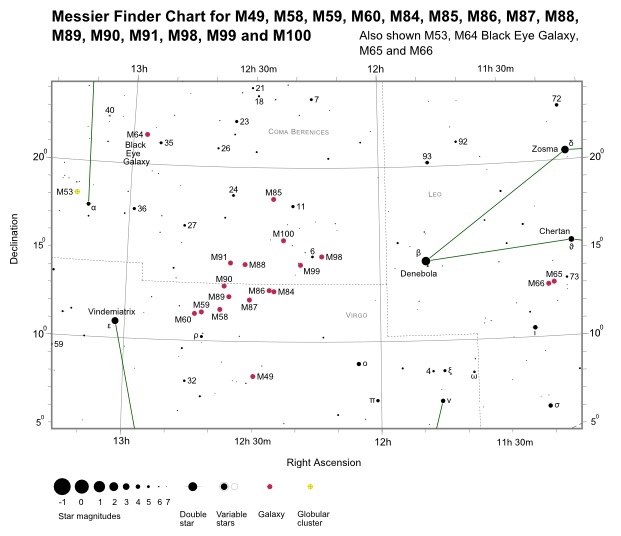M64 is a beautiful spiral galaxy that's known as the Black Eye Galaxy, due to a spectacular dark band of absorbing dust in front of the nucleus that results in a smudged appearance. With an apparent magnitude of +8.8, it can be glimpsed with good binoculars on dark nights appearing as a faint slightly irregular patch of light.
This galaxy is located in the constellation of Coma Berenices and was discovered by English astronomer Edward Pigott on March 23, 1779. Twelve days later Johann Elert Bode independently found it and Charles Messier adding it to his catalogue on March 1, 1780. The dark dust feature was first noticed by William Herschel in 1785, who coined the black eye name.
M64 is located 5 degrees northwest of Diadem (α Com - mag. +4.3) on an imaginary line connecting stars, 35 Comae Berenices (mag. +4.9) and 40 Comae Berenices (mag. +5.5). It's positioned one degree northeast of 35 Comae Berenices. Arcturus, the brightest star in the northern section of the sky and fourth brightest overall is located 19 degrees to the east and a couple of degrees to the south. M64 is located 24 Million light-years distant and has an apparent size of 10.0 x 5.4 arc minutes, which corresponds to an actual diameter of 70,000 light-years. It's estimated to contain 100 billion stars and is best seen from northern latitudes during the months of March, April and May.


Finder Chart for M64 - pdf format (credit:- freestarcharts)

The Black Eye Galaxy is an extremely rewarding telescope object that's one of the brightest and easily observed spirals in the sky. When viewed through a 100mm (4-inch) telescope, it appears irregular in shape with a general uneven brightness and a large bright core. On nights of excellent seeing, the characteristic standout dark dust lane can be glimpsed with a telescope of this size but is much easier to spot with larger scopes. When viewed through 150mm (6-inch) instruments, the oval-shaped is accentuated with the dark dust lane quite apparent. A 250mm (10-inch) scope reveals the dark patch, a sharp condensed bright core surrounded by a large outer envelope of wispy nebulosity. It's a superb object.
To date, no supernova has ever been recorded in M64.
M64 Data Table
| Messier | 64 |
|---|---|
| NGC | 4826 |
| Name | Black Eye Galaxy |
| Object Type | Spiral galaxy |
| Classification | SA(rs)ab |
| Constellation | Coma Berenices |
| Distance (light-years) | 24 Million |
| Apparent Mag. | +8.8 |
| RA (J2000) | 12h 56m 44s |
| DEC (J2000) | +21d 40m 58s |
| Apparent Size (arc mins) | 10.0 x 5.4 |
| Radius (light-years) | 35,000 |
| Number of Stars | 100 Billion |
| Notable Feature | Also known as Sleeping Beauty Galaxy or sometimes Evil Eye Galaxy |